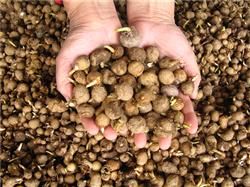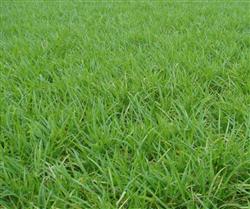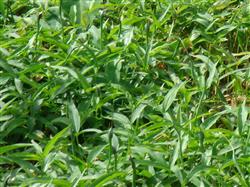How to cultivate Pinellia ternata?

How to cultivate Pinellia ternata? Please give guidance to Pinellia ternata alias Pinellia ternata, Sanbaotiao, Ma Yuguo, which are commonly used Chinese herbal medicines, which are distributed in the north and south of our country. In recent years, due to the reclamation and utilization of barren mountains and the extensive use of herbicides in farmland, the ecological environment has been destroyed, the resources have decreased year by year, and the price has been rising. According to the survey, at present, Pinellia ternata commodities are scarce in 17 professional markets across the country, and the supply exceeds demand, and the market price is firm at 36-42 yuan / kg. Therefore, the market prospect of artificial planting Pinellia ternata is very broad. In recent years, through introduction and cultivation experiments, the relevant scientific and technological personnel in the GAP planting base of our traditional Chinese Medicine Association have successfully transformed wild Pinellia ternata into domestic species, and the yield per mu has reached 160kg (dry products). Excluding the cost and expenditure, the profit per mu is more than 3500 yuan, and good economic benefits have been obtained. The main points of its introduction and cultivation techniques are introduced as follows: first, the selection of planting site. Dry Pinellia ternata prefers mild and humid climate, cold and shade tolerance, not drought tolerance, suitable for hillside, flat land cultivation, interplanting with fruit trees, and intercropping with corn, rape, wheat and other high-stem plants, sandy soil is the best, heavy clay and low-lying waterlogged land is not suitable for planting. Second, planting. The suitable sowing period of Pinellia ternata is from November in winter to April of the following year. Before sowing, 2000 kg of stable manure or compost and 25 kg of superphosphate are applied per mu, turned into the soil as base fertilizer, ploughed and turned again when sowing, and then raked flat. Pinellia ternata is mainly propagated by tubers and plant buds. It is best to use tubers to reproduce, plant along with digging, dig holes according to row spacing of 17-20 cm and plant spacing of 7-10 cm, plant two to three tubers per hole, use 40-50 kg tubers per mu, cover soil not too thick, 1-2 cm is appropriate, and water in time if the soil is dry. When the old leaves are about to wither and the plant buds under the petiole have matured in summer and autumn, the mature plant buds should be used for strip planting, and the row distance is the same as that of the tuber. Third, field management ⑴ weeding: weeding in time before the seedlings are closed, the depth of ploughing should not exceed 5 cm, so as to avoid root damage. Because the root of Pinellia ternata grows around the tuber, and the root system is concentrated in the topsoil layer of 12-15 cm, the middle ploughing should be shallow rather than deep. ⑵ fertilization: after the seedlings emerged, 1000 kg of human and animal feces were applied at 1:3 per mu and 2000 kg of human and animal manure were applied per mu during the bud formation stage. When the new buds appeared in Pinellia ternata and the shelled female Pinellia ternata grew new roots, it was poured with 1:10 dung water. After that, 25 kg of rotten cake fertilizer, 20 kg of superphosphate and 10 kg of urea were applied per mu according to the growth situation. Prevention and control of ⑶ diseases and insect pests: leaf spot disease and virus disease are more likely to occur in Pinellia ternata. Leaf spot disease can be controlled by spraying with Bordeaux solution of 1purl 120 or 65% Dysen zinc 500x solution, once every 7-10 days, 2-3 times in a row; 5% lime milk can be used to control virus disease, and the diseased plants can be removed and burned in time. The main pest is Spodoptera litura. The control method is to spray 1000-fold liquid of 90% crystal trichlorfon, once every 5-7 days, 2-3 times in a row. Fourth, harvest and processing. The growth period of Pinellia ternata is 180-210 days, and tuber propagation can be harvested in the same year or the next year according to the sowing season. Generally in summer and autumn stems and leaves withered after digging, choose a sunny day to carefully dig tubers to avoid damage, shake off the sediment, put into the basket to cover. Do not expose yourself to the sun, or it will not be easy to peel. When processing, the fresh Pinellia ternata is graded according to large, medium and small, and then put into a sack, gently beat on the ground, then poured into a clear water tank, knead repeatedly until the skin is clean, and then take out to dry. Click to get more planting techniques of Pinellia ternata
- Prev

How to cultivate Pinellia ternata?
How to cultivate Pinellia ternata? Please give guidance to Pinellia ternata, also known as Pinellia ternata, with tuber as medicine, which has the effect of detoxification, detumescence and hemostasis. According to pharmacological tests, its effect is the same as that of Pinellia ternata, but its toxicity is less than Pinellia ternata, mainly in Guangxi, especially in Pingnan and Guiping. It is better to plant with deep and fertile sandy loam. Cultivate.
- Next

How to plant Pinellia ternata?
How to plant Pinellia ternata? Please give a detailed introduction to Pinellia ternata, three-leaf Pinellia ternata, three-step jump, Ma Yuguo, swallow tail, etc. It belongs to Pinellia ternata of Araceae. Pinellia ternata is a commonly used traditional Chinese medicine, with tubers for medicinal purposes, with dryness, dampness and phlegm, anti-vomiting and other functions, raw Pinellia ternata is poisonous. Mainly produced in the provinces of the Yangtze River Basin, now all over the country.
Related
- Fuxing push coffee new agricultural production and marketing class: lack of small-scale processing plants
- Jujube rice field leisure farm deep ploughing Yilan for five years to create a space for organic food and play
- Nongyu Farm-A trial of organic papaya for brave women with advanced technology
- Four points for attention in the prevention and control of diseases and insect pests of edible fungi
- How to add nutrient solution to Edible Fungi
- Is there any good way to control edible fungus mites?
- Open Inoculation Technology of Edible Fungi
- Is there any clever way to use fertilizer for edible fungus in winter?
- What agents are used to kill the pathogens of edible fungi in the mushroom shed?
- Rapid drying of Edible Fungi

